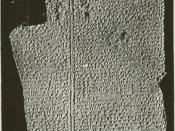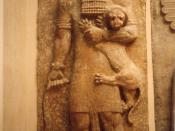The Epic of Gilgamesh
Western literature has few epics of any real greatness. Of these, The Epic of Gilgamesh is by far the oldest. The standard version of the epic, preceded Homer's Iliad and Odyssey by centuries. And the story of Gilgamesh's deeds is much older then that, maybe as old as the cult religion that worshipped Gilgamesh as a deity around 2600 B.C.E.
But what does it mean to call Gilgamesh an "epic"? The epic form itself is sometimes traced to Homer, to define five common features to epics: 1) there is a hero of great national or even universal importance; 2) there is a vast canvas, a setting that may be the whole world or larger; 3) the plot involves battles involving superhuman deeds or a long, difficult journey; 4) gods or other supernatural beings are interested and involved; 5) there is a ritualized, performative aspect, a style more ceremonial than ordinary speech.
In Gilgamesh we have a story, older than Homer, which fulfills all of these criteria. Gilgamesh is the mightiest of ancient kings, a cultural hero and, like Achilles, the son of a goddess. Gilgamesh's narrative spans not just the known world of Mesopotamia but also the sea beyond the world's end, and the tunnels through which the sun travels back to its resting place. We have superhuman achievements in battle, the defeat of Humbaba and the Bull of Heaven, and also a lengthy and difficult journey. We have the active involvement of much of the Babylonian pantheon of gods, including Ea, Enlil, Ishtar and Shamash. And we certainly have a ceremonial style.
Formally, Gilgamesh is a verse poem. It is about 3000 lines long, divided in 11 sections, according to how it was originally recorded on 11 clay tablets. It is divided into "verses," or...


